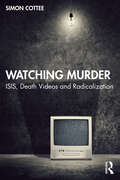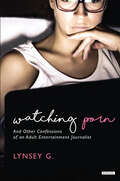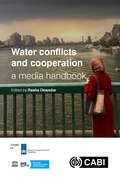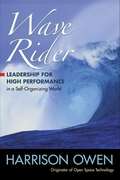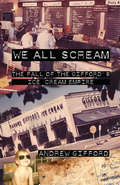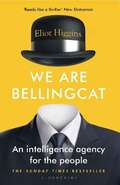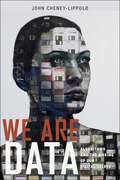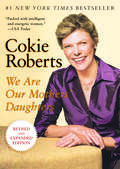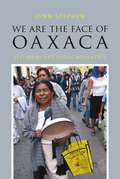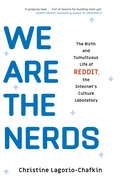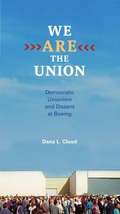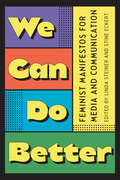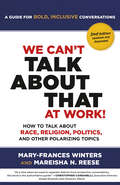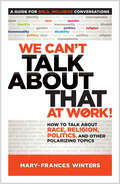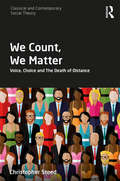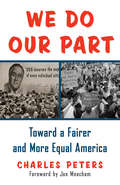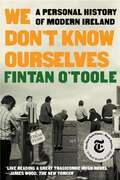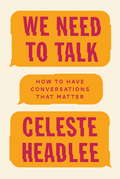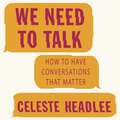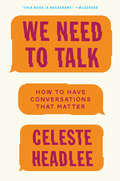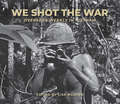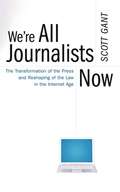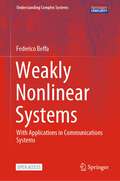- Table View
- List View
Watching Murder: ISIS, Death Videos and Radicalization
by Simon CotteeWatching Murder shines a light onto the dark world of jihadi murder videos and the people who watch and share them on the internet. Images and videos of murder, torture and other cruelties are everywhere on the internet. Why do some people seek out and watch this material, how are they affected by it and do they have a right to watch any of it in the first place? In this ground-breaking book, terrorism scholar Simon Cottee visits the murky fringes of the internet in search of answers. Focusing on ISIS, he shows how the group transformed the urban myth of the snuff movie into a grim reality watched by tens of thousands of people across the globe. On shock-sites, he finds a contingent of ISIS fans who, while hating the group, love to watch its most monstrous depredations in high definition. He interviews his fellow extremism researchers and asks them about all the dark things they have seen online and how this has affected their mental health. He speaks with the "cleaners" whose job is to report and remove violent jihadi propaganda from the internet. And he surveys thousands of young adults to find out what they think of ISIS and its notorious beheading videos. Cottee exposes the hysteria around online radicalization, and shows how our engagement with violent online spectacles is much more complex and multifaceted than many would have us believe. Watching Murder will appeal to anyone with an interest in violence, media, terrorism and ISIS. It will be of particular interest to students and scholars of terrorism studies, political science, culture and communication.
Watching Porn: And Other Confessions of an Adult Entertainment Journalist
by Lynsey G“Lynsey G. is an intrepid explorer, boldly going where few reporters have gone with such a critical eye: deep inside the real world of commercial sex.” —Tina Horn, host of the Why Are People Into That?! podcast Lynsey G. never imagined that she would ever work in porn, but at twenty-four years old, with a degree in English literature and an empty bank account, she found herself reviewing the film East Coast ASSault for an adult magazine in New York City. One interview later and it was official: she was a porn journalist. The job was supposed to be temporary—just a paycheck until she could spark her legitimate writing career—but she loved it and spent nearly a decade describing the nuances of money shots and the effectiveness of sex toys. As both a porn consumer and a porn critic, she was not quite an insider, not quite an outsider, but came to know the industry intimately.She found it so fascinating that she co-founded WHACK! Magazine. Finally, she had a platform to voice her thoughts and observations of the adult film world, as well as educate the rest of us about what really goes on behind the scenes. Eventually, Lynsey was thrust back into the “real” world, but not before realizing that one of the most diverse and nebulous—and profitable—industries on the planet isn’t so quite as different from the rest of the world as she thought. Tantalizing, eye-opening, and witty, Watching Porn is a provocative book about an average girl’s foray into the porn industry and the people who make it what it is, both in front of and behind the camera.“Marvelous.” —The New York Times Book Review
Water Conflicts and Cooperation: A Media Handbook
by Ali ThompsonThis handbook is for journalists, researchers and policy makers that are interested in working on science communication for water peace and cooperation and that are searching for ideas and inspiration. It features descriptions and reflections of the activities (action research, training modules, joint workshops, reporting grants, podcast, online photo campaign...) implemented by Open Water Diplomacy project in the Nile basin, and in the new international basins identified under the top-up activities on capacity development, as well as activities in the field of media and water diplomacy implemented by other actors. It will be an online open access repository of case studies and best practices in the field of journalism and science communication for water peace and cooperation.
Wave Rider: Leadership for High Performance
by Harrison OwenWave Rider is about leveraging the power of self-organization for high performance in all sizes and types of organizations.
Waveform Analysis of Sound
by Mikio TohyamaWhat is this sound? What does that sound indicate? These are two questions frequently heard in daily conversation. Sound results from the vibrations of elastic media and in daily life provides informative signals of events happening in the surrounding environment. In interpreting auditory sensations, the human ear seems particularly good at extracting the signal signatures from sound waves. Although exploring auditory processing schemes may be beyond our capabilities, source signature analysis is a very attractive area in which signal-processing schemes can be developed using mathematical expressions. This book is inspired by such processing schemes and is oriented to signature analysis of waveforms. Most of the examples in the book are taken from data of sound and vibrations; however, the methods and theories are mostly formulated using mathematical expressions rather than by acoustical interpretation. This book might therefore be attractive and informative for scientists, engineers, researchers, and graduate students who are interested in the mathematical representation of signals and the applications of Fourier analysis. The book can be described as being practically self-contained but does assume readers are familiar with introductory topics in discrete signal processing, as in the discrete Fourier transform. Hence this book might be also usable as a textbook in graduate courses in applied mathematics on topics such as complex functions. Almost all scientific phenomena are sensed as waves propagating in some space. Over the years, waveform analysis has therefore been one of the resilient academic areas of study and still is seen as fertile ground for development. In particular, waveform analysis based on the theory of linear systems would be a good example where a physical interpretation can be given to the mathematical theory of complex functions in terms of magnitude, angle, poles, and zeros of complex functions. For readers who are interested in the physical aspects of sound and vibration data or elementary formulation of wave equations and their solutions, the book Sound and Signals by M. Tohyama (Springer 2011) is recommended. It can serve as a complementary companion to this present volume or independently as a good reference.
We All Scream: The Fall of the Gifford's Ice Cream Empire
by Andrew GiffordFor more than 70 years, Gifford's Ice Cream and Candy Company was associated with nothing but pleasure for native Washingtonians and visitors to the nation's capital. Few knew the dark truth... Behind the iconic business's happy facade lay elaborate schemes, a crushing bankruptcy, two million dollars of missing cash, and a tragic suicide. As the last Gifford heir unfolds his story with remarkable immediacy and candor, he reveals the byzantine betrayals and intrigue rooted in the company from its modest beginnings—dark influences that would ultimately destroy the legendary Gifford business and its troubled founding family.
We Are Bellingcat: Global Crime, Online Sleuths, and the Bold Future of News
by Eliot HigginsTHE SUNDAY TIMES BESTSELLER <p><p> 'John le Carré demystified the intelligence services; Higgins has demystified intelligence gathering itself' Financial Times <p><p> 'Uplifting . . . Riveting . . . What will fire people through these pages, gripped, is the focused, and extraordinary investigations that Bellingcat runs . . . Each runs as if the concluding chapter of a Holmesian whodunit' Telegraph <p><p> 'We Are Bellingcat is Higgins's gripping account of how he reinvented reporting for the internet age . . . A manifesto for optimism in a dark age' Luke Harding, Observer <p><p> How did a collective of self-taught internet sleuths end up solving some of the biggest crimes of our time? <p><p> Bellingcat, the home-grown investigative unit, is redefining the way we think about news, politics and the digital future. Here, their founder - a high-school dropout on a kitchen laptop - tells the story of how they created a whole new category of information-gathering, galvanising citizen journalists across the globe to expose war crimes and pick apart disinformation, using just their computers. <p><p> From the downing of Malaysia Flight 17 over the Ukraine to the sourcing of weapons in the Syrian Civil War and the identification of the Salisbury poisoners, We Are Bellingcat digs deep into some of Bellingcat's most successful investigations. It explores the most cutting-edge tools for analysing data, from virtual-reality software that can build photorealistic 3D models of a crime scene, to apps that can identify exactly what time of day a photograph was taken. <p><p> In our age of uncertain truths, Bellingcat is what the world needs right now - an intelligence agency by the people, for the people.
We Are Data: Algorithms and the Making of Our Digital Selves
by John Cheney-LippoldWhat identity means in an algorithmic age: how it works, how our lives are controlled by it, and how we can resist itAlgorithms are everywhere, organizing the near limitless data that exists in our world. Derived from our every search, like, click, and purchase, algorithms determine the news we get, the ads we see, the information accessible to us and even who our friends are. These complex configurations not only form knowledge and social relationships in the digital and physical world, but also determine who we are and who we can be, both on and offline. Algorithms create and recreate us, using our data to assign and reassign our gender, race, sexuality, and citizenship status. They can recognize us as celebrities or mark us as terrorists. In this era of ubiquitous surveillance, contemporary data collection entails more than gathering information about us. Entities like Google, Facebook, and the NSA also decide what that information means, constructing our worlds and the identities we inhabit in the process. We have little control over who we algorithmically are. Our identities are made useful not for us—but for someone else. Through a series of entertaining and engaging examples, John Cheney-Lippold draws on the social constructions of identity to advance a new understanding of our algorithmic identities. We Are Data will educate and inspire readers who want to wrest back some freedom in our increasingly surveilled and algorithmically-constructed world.
We Are Our Mothers' Daughters: Revised And Expanded Edition
by Cokie RobertsThe “entertaining and evocative” #1 New York Times bestseller, profiling extraordinary women from mother to mechanic and sister to soldier (The Hill).This is a revised and expanded edition of legendary journalist Cokie Roberts’s collection of personal essays and biographical profiles, “a celebration of women in their various roles: mother, sister, civil rights advocate, consumer advocate, first-class mechanic, politician—which Roberts’ own mother once was” (The Washington Post).“A flock of fascinating women.” —Dallas Morning News“Inspirational stories of women who have successfully nurtured their children while working outside the home. With humor, honesty, and optimism, [Roberts] provides perspective on this balancing act.” —Newsday“Her subject matter intrigues for both her personal spin and the biographies of unusual and powerful women.” —Los Angeles Times“Lively reading.” —USA Today
We Are the Face of Oaxaca: Testimony and Social Movements
by Lynn StephenA massive uprising against the Mexican state of Oaxaca began with the emergence of the Popular Assembly of the Peoples of Oaxaca (APPO) in June 2006. A coalition of more than 300 organizations, APPO disrupted the functions of Oaxaca's government for six months. It began to develop an inclusive and participatory political vision for the state. Testimonials were broadcast on radio and television stations appropriated by APPO, shared at public demonstrations, debated in homes and in the streets, and disseminated around the world via the Internet. The movement was met with violent repression. Participants were imprisoned, tortured, and even killed. Lynn Stephen emphasizes the crucial role of testimony in human rights work, indigenous cultural history, community and indigenous radio, and women's articulation of their rights to speak and be heard. She also explores transborder support for APPO, particularly among Oaxacan immigrants in Los Angeles. The book is supplemented by a website featuring video testimonials, pictures, documents, and a timeline of key events.
We Are the Nerds: The Birth and Tumultuous Life of REDDIT, the Internet's Culture Laboratory
by Christine Lagorio-Chafkin'A gripping read' Adam Grant, bestselling author of OriginalsReddit hails itself as 'the front page of the Internet'. It's the sixth most-visited website in the world - and yet, millions have no idea what it is. They should be paying attention.This definitive account of the birth and life of Reddit is perfect for readers of The Everything Store, Googled and The Facebook Effect.We Are the Nerds takes readers inside this captivating, maddening enterprise, whose army of obsessed users have been credited with everything from solving crimes and spurring millions in charitable donations to seeding alt-right fury and even landing Donald Trump in the White House. Reddit has become a mirror of the Internet itself: It has dark trenches, shiny memes, malicious trolls, and a heart-warming ability to connect people across cultures, oceans, and ideological divides.This is the gripping story of how Reddit's founders, Steve Huffman and Alexis Ohanian, transformed themselves from student video-gamers into Silicon Valley millionaires as they turned their creation into an icon of the digital age. But the journey was often fraught. Reporting on Reddit for more than six years, conducting hundreds of interviews and gaining exclusive access to its founders, Christine Lagorio-Chafkin has written the definitive account of the birth and life of Reddit. Packed with revelatory details about its biggest triumphs and controversies, this inside look at Reddit includes fresh insights on the relationship between Huffman and Ohanian, staff turmoil, the tragic life of Aaron Swartz, and Reddit's struggle to become profitable.In a time when we are increasingly concerned about privacy and manipulation on social platforms, We Are the Nerds reveals Reddit's central role in the dissemination of culture and information in history's first fully digital century. Rigorously reported and highly entertaining, We Are the Nerds explores how this unique platform has changed the way we all communicate today.PRAISE FOR THE BOOK:'Incisive, witty and brilliantly written' - Emily Chang, bestselling author of Brotopia'A triumph - a business book that reads like a page-turning novel' - James Ledbetter, author of One Nation Under Gold'The best, grittiest, most accurate book yet about what it's like to build a startup and a community from scratch' - John Zeratsky, bestselling author of Sprint and Make Time'A gripping, entertaining book that is a must-read for every entrepreneur' - Daymond John, bestselling author of Rise and Grind'Too many books on tech feel like they have been Googled together; Lagorio-Chafkin's is rich in original reportage' - TLS
We Are the Union: Democratic Unionism and Dissent at Boeing
by Dana L. CloudIn this extraordinary tale of union democracy, Dana L. Cloud engages union reformers at Boeing in Wichita and Seattle to reveal how ordinary workers attempted to take command of their futures by chipping away at the cozy partnership between union leadership and corporate management. Taking readers into the central dilemma of having to fight an institution while simultaneously using it as a bastion of basic self-defense, We Are the Union offers a sophisticated exploration of the structural opportunities and balance of forces at play in modern unions told through a highly relevant case study. Focusing on the 1995 strike at Boeing, Cloud renders a multi-layered account of the battles between company and the union and within the union led by Unionists for Democratic Change and two other dissident groups. She gives voice to the company's claims of the hardships of competitiveness and the entrenched union leaders' calls for concessions in the name of job security, alongside the democratic union reformers' fight for a rank-and-file upsurge against both the company and the union leaders. We Are the Union is grounded in on-site research and interviews and focuses on the efforts by Unionists for Democratic Change to reform unions from within. Incorporating theory and methods from the fields of organizational communication as well as labor studies, Cloud methodically uncovers and analyzes the goals, strategies, and dilemmas of the dissidents who, while wanting to uphold the ideas and ideals of the union, took up the gauntlet to make it more responsive to workers and less conciliatory toward management, especially in times of economic stress or crisis. Cloud calls for a revival of militant unionism as a response to union leaders' embracing of management and training programs that put workers in the same camp as management, arguing that reform groups should look to the emergence of powerful industrial unions in the United States for guidance on revolutionizing existing institutions and building new ones that truly accommodate workers' needs. Drawing from communication studies, labor history, and oral history and including a chapter co-written with Boeing worker Keith Thomas, We Are the Union contextualizes what happened at Boeing as an exemplar of agency that speaks both to the past and the future.
We Can Do Better: Feminist Manifestos for Media and Communication
by Meenakshi Gigi Durham Carolyn Kitch Lori Kido Lopez Linda Steiner Sahar Khamis Kim Hong Nguyen Summer Harlow Dafna Lemish Dustin Harp Stine Eckert Miglena Sternadori Eve Ng Gina M. Masullo Frieda Werden Denetra Walker Erin L. Perry Carolina Velloso Katy Fulfer Jade Metzger-Riftkin Amara Imari SugalskiFeminist Manifestos for Media and Communication brings together evidence-based manifestos for media and communication that take a feminist perspective and add up to a provocative vision of feminist media practices and of feminist communication. The book discusses critical problems and complaints in ways that identify and make the case for actionable, concrete solutions to media problems and deficiencies; it shows how feminist thinking can be usefully and effectively applied to a wide range of journalism, media, and communication practices. The manifestos are not “only” about women but rather offer specific, feasible blueprints for restructuring media in ways that make them fairer and more equitable along many vectors of identity, so that media can better serve democracy. These manifestos give concrete solutions to specific problems that can and should be implemented by journalists, media practitioners, students, faculty, and scholars. The manifestos are organized around three sets of demands: for better media practices, for more participatory online spaces, and for more precise and appropriate language.
We Can't Talk about That at Work! Second Edition: How to Talk about Race, Religion, Politics, and Other Polarizing Topics
by Mary-Frances Winters Mareisha ReeseIn developing the skills necessary to engage in Bold, Inclusive Conversations around polarizing topics, we can acknowledge that these subjects are complex, that there are no simple answers, and that it takes time and practice to learn how to do it well.Politics, religion, race-we can't talk about topics like these at work, right? But in fact, these conversations are happening all the time, either in real life or virtually. And if they aren't handled effectively, they can become more polarizing and divisive, impacting productivity, engagement, retention, teamwork, and even employees' sense of safety in the workplace.In this second edition of We Can't Talk about That at Work!, best-selling author Mary-Frances Winters and new coauthor Mareisha N. Reese of The Winters Group, Inc., provide fresh examples, updated research, and compelling insights. Featuring a new chapter on how two organizations have actualized the model for Bold, Inclusive Conversations as well as a discussion guide and updated glossary, this modern classic offers step-by-step guidance for conducting structured conversations around polarizing topics. Leaders and organizations can address sensitive subjects head on in a way that brings people together instead of driving them apart.
We Can't Talk about That at Work!: How to Talk About Race, Religion, Politics, and Other Polarizing Topics
by Mary-Frances WintersInstead of shutting down any mention of taboo topics, Mary-Frances Winters shows how to structure intentional conversations about them, so people can safely confront biases and stereotypes and create stronger, more inclusive organizations.Politics, religion, race - we can't talk about topics like these at work, right? But in fact, these conversations are happening all the time, either in real life or virtually via social media. And if they aren't handled effectively, they can become more polarizing and divisive, impacting productivity, engagement, retention, teamwork, and even employees' sense of safety in the workplace. But you can turn that around and address difficult topics in a way that brings people together instead of driving them apart. As a thought leader in the field of diversity and inclusion, Mary-Frances Winters has been helping clients create inclusive environments for over three decades. In this concise and powerful book, she shows you how to lay the groundwork for having bold, inclusive conversations. Even with the best of intentions, you can't just start talking about taboo topics - that's wandering into a minefield. Winters offers exercises and tools to help you become aware of how your cultural background has shaped your perceptions and habits and to increase your understanding of how people from other cultures may differ from you, particularly when it comes to communicating and handling conflict. Once you're ready (you can take the self-assessment included in the book to make sure), Winters gives detailed instructions on exactly how to structure these conversations. She emphasizes that this is a process, not a destination—you may not be able to resolve major issues nicely and neatly in just one conversation. And while the process is important, so is intent. She urges readers to &“come from your heart, learn from your mistakes, and continue to contribute to making this a more inclusive world for all.&”
We Count, We Matter: Voice, Choice and the Death of Distance (Classical and Contemporary Social Theory)
by Christopher SteedThis book examines the meaning of Brexit, the election of Trump and the rising tide of populist revolt on the right amidst the collapse of the left. Exploring the reaction against the establishment or ‘the system’, the author contends that we are witnessing a new divide between those who wish to see an interconnected world and those who seek distance: as transport and technology shrink the world, we witness a backlash that favours protectionism and opposes immigration. Distance is the new frontier: for some, remote players are rejected in favour of identities closer to home. This divide plays out in relation to the notion of ‘face’, as individuals react to ‘faceless’ organisations and processes such as globalisation and automation, responding to a sense of alienation on social media and developing a conception of themselves as networked individuals. Thus, we move towards a type of society characterised not by honour and dishonour, or right and wrong, but by voice and choice. A fascinating and very accessible analysis of the divisions and transformations that have come to dominate the contemporary landscape, this book will appeal to political leaders and social scientists with interests in globalisation, social movements and social theory.
We Do Our Part: Toward a Fairer and More Equal America
by Jon Meacham Charles PetersThe legendary editor who founded the Washington Monthly and pioneered explanatory journalism trains his keen, principled eye on the changes that have reshaped American politics and civic life beginning with the New Deal. “We Do Our Part” was the slogan of Franklin Delano Roosevelt’s National Recovery Administration—and it captured the can-do spirit that allowed America to survive the Great Depression and win World War II. Although the intervening decades have seen their share of progress as well, in some ways we have regressed as a nation. Over the course of a sixty-year career as a Washington, D.C., journalist, historian, and challenger of conventional wisdom, Charles Peters has witnessed these drastic changes firsthand. This stirring book explains how we can consolidate the gains we have made while recapturing the generous spirit we have lost. In a volume spanning the decades, Peters compares the flood of talented, original thinkers who flowed into the nation’s capital to join FDR’s administration with the tide of self-serving government staffers who left to exploit their opportunities on Wall Street and as lobbyists from the 1970s to today. During the same period, the economic divide between rich and poor grew, as we shifted from a culture of generosity to one of personal aggrandizement. With the wisdom of a prophet, Peters connects these two trends by showing how this money-fueled elitism has diminished our trust in one another and our nation—and changed Washington for the worse. While Peters condemns the crass buckraking that afflicts our capital, and the rampant consumerism that fuels our greed, he refuses to see America’s downward drift as permanent. By reminding us of our vanished civic ideal, We Do Our Part also points the way forward. Peter argues that if we want to revive the ethos of the New Deal era—a time when government attracted the brightest and the most dedicated, and when our laws reflected a spirit of humility and community—we need only demand it of ourselves and our elected officials. With a new administration in Washington, the time is ripe for a reassessment of our national priorities. We Do Our Part offers a vital road map of where we have been and where we are going, drawn from the invaluable perspective of a man who has seen America’s better days and still believes in the promise that lies ahead.
We Don't Know Ourselves: A Personal History of Modern Ireland
by Fintan O'TooleNEW YORK TIMES BESTSELLER NEW YORK TIMES • 10 BEST BOOKS OF THE YEAR NATIONAL BESTSELLER The Atlantic: 10 Best Books of 2022 Best Books of the Year: Washington Post, New Yorker, Salon, Foreign Affairs, New Statesman, Chicago Public Library, Vroman's “[L]ike reading a great tragicomic Irish novel.” —James Wood, The New Yorker “Masterful . . . astonishing.” —Cullen Murphy, The Atlantic "A landmark history . . . Leavened by the brilliance of O'Toole's insights and wit.” —Claire Messud, Harper’s Winner • 2021 An Post Irish Book Award — Nonfiction Book of the Year • from the judges: “The most remarkable Irish nonfiction book I’ve read in the last 10 years”; “[A] book for the ages.” A celebrated Irish writer’s magisterial, brilliantly insightful chronicle of the wrenching transformations that dragged his homeland into the modern world. Fintan O’Toole was born in the year the revolution began. It was 1958, and the Irish government—in despair, because all the young people were leaving—opened the country to foreign investment and popular culture. So began a decades-long, ongoing experiment with Irish national identity. In We Don’t Know Ourselves, O’Toole, one of the Anglophone world’s most consummate stylists, weaves his own experiences into Irish social, cultural, and economic change, showing how Ireland, in just one lifetime, has gone from a reactionary “backwater” to an almost totally open society—perhaps the most astonishing national transformation in modern history. Born to a working-class family in the Dublin suburbs, O’Toole served as an altar boy and attended a Christian Brothers school, much as his forebears did. He was enthralled by American Westerns suddenly appearing on Irish television, which were not that far from his own experience, given that Ireland’s main export was beef and it was still not unknown for herds of cattle to clatter down Dublin’s streets. Yet the Westerns were a sign of what was to come. O’Toole narrates the once unthinkable collapse of the all-powerful Catholic Church, brought down by scandal and by the activism of ordinary Irish, women in particular. He relates the horrific violence of the Troubles in Northern Ireland, which led most Irish to reject violent nationalism. In O’Toole’s telling, America became a lodestar, from John F. Kennedy’s 1963 visit, when the soon-to-be martyred American president was welcomed as a native son, to the emergence of the Irish technology sector in the late 1990s, driven by American corporations, which set Ireland on the path toward particular disaster during the 2008 financial crisis. A remarkably compassionate yet exacting observer, O’Toole in coruscating prose captures the peculiar Irish habit of “deliberate unknowing,” which allowed myths of national greatness to persist even as the foundations were crumbling. Forty years in the making, We Don’t Know Ourselves is a landmark work, a memoir and a national history that ultimately reveals how the two modes are entwined for all of us.
We Need To Talk: How to Have Conversations That Matter
by Celeste HeadleeTake a moment to consider how many outcomes in your life may have been affected by poor communication skills. Could you have gotten a job you really wanted? Saved a relationship? What about that political conversation that got out of hand at a dinner party? How is it that we so often fail to say the right thing at the right time?In her career as an NPR host, journalist Celeste Headlee has interviewed hundreds of people from all walks of life, and if there's one thing she's learned, it's that it's hard to overestimate the power of conversation and its ability to both bridge gaps and deepen wounds. In We Need to Talk, she shares what she's learned on the job about how to have effective, meaningful, and respectful conversations in every area of our lives.Now more than ever, Headlee argues, we must begin to talk to and, more importantly, listen to one another - including those with whom we disagree. We Need to Talk gives readers ten simple tools to help facilitate better conversations, ranging from the errors we routinely make (put down the smart phone when you're face to face with someone) to the less obvious blind spots that can sabotage any conversation, including knowing when not to talk, being aware of our own bias, and avoiding putting yourself in the centre of the discussion.Whether you're gearing up for a big conversation with your boss, looking to deepen or improve your connection with a relative, or trying to express your child's needs to a teacher, We Need to Talk will arm you with the skills you need to create a productive dialogue.
We Need To Talk: How to Have Conversations That Matter
by Celeste HeadleeTake a moment to consider how many outcomes in your life may have been affected by poor communication skills. Could you have gotten a job you really wanted? Saved a relationship? What about that political conversation that got out of hand at a dinner party? How is it that we so often fail to say the right thing at the right time?In her career as an NPR host, journalist Celeste Headlee has interviewed hundreds of people from all walks of life, and if there's one thing she's learned, it's that it's hard to overestimate the power of conversation and its ability to both bridge gaps and deepen wounds. In We Need to Talk, she shares what she's learned on the job about how to have effective, meaningful, and respectful conversations in every area of our lives.Now more than ever, Headlee argues, we must begin to talk to and, more importantly, listen to one another - including those with whom we disagree. We Need to Talk gives readers ten simple tools to help facilitate better conversations, ranging from the errors we routinely make (put down the smart phone when you're face to face with someone) to the less obvious blind spots that can sabotage any conversation, including knowing when not to talk, being aware of our own bias, and avoiding putting yourself in the centre of the discussion.Whether you're gearing up for a big conversation with your boss, looking to deepen or improve your connection with a relative, or trying to express your child's needs to a teacher, We Need to Talk will arm you with the skills you need to create a productive dialogue.
We Need to Talk: How to Have Conversations That Matter
by Celeste Headlee“WE NEED TO TALK.”In this urgent and insightful book, public radio journalist Celeste Headlee shows us how to bridge what divides us--by having real conversationsBASED ON THE TED TALK WITH OVER 10 MILLION VIEWS“We Need to Talk is an important read for a conversationally-challenged, disconnected age. Headlee is a talented, honest storyteller, and her advice has helped me become a better spouse, friend, and mother.” (Jessica Lahey, author of New York Times bestseller The Gift of Failure)Today most of us communicate from behind electronic screens, and studies show that Americans feel less connected and more divided than ever before. The blame for some of this disconnect can be attributed to our political landscape, but the erosion of our conversational skills as a society lies with us as individuals. And the only way forward, says Headlee, is to start talking to each other. In We Need to Talk, she outlines the strategies that have made her a better conversationalist—and offers simple tools that can improve anyone’s communication. For example: BE THERE OR GO ELSEWHERE. Human beings are incapable of multitasking, and this is especially true of tasks that involve language. Think you can type up a few emails while on a business call, or hold a conversation with your child while texting your spouse? Think again.CHECK YOUR BIAS. The belief that your intelligence protects you from erroneous assumptions can end up making you more vulnerable to them. We all have blind spots that affect the way we view others. Check your bias before you judge someone else.HIDE YOUR PHONE. Don’t just put down your phone, put it away. New research suggests that the mere presence of a cell phone can negatively impact the quality of a conversation. Whether you’re struggling to communicate with your kid’s teacher at school, an employee at work, or the people you love the most—Headlee offers smart strategies that can help us all have conversations that matter.
We Shot the War: Overseas Weekly in Vietnam
by Lisa NguyenWe Shot the War: Overseas Weekly in Vietnam examines the legacy of one of the most popular and eccentric newspapers to cover the Vietnam War. With its mix of hard-hitting military exposÉs, pinups, and comic strips, Overseas Weekly earned a reputation as a muckraking truth teller. Time magazine called it "the least popular publication at the Pentagon." From 1966 to 1972, the paper's reporters and photographers tackled controversial topics, including courts-martial, racial discrimination, drug use, and opposition to command. And they published some of the most intimate portraits of American GIs and Vietnamese civilians, taken with the specific purpose of documenting the daily life of individuals caught in the world's most grueling and disputed conflict. Through striking photographs and personal essays, We Shot the War brings viewers behind the viewfinders of photojournalists who covered the conflict and introduces readers to two extraordinary women: founder Marion von Rospach and Saigon office bureau chief Ann Bryan. Together, they fought for the right of women to report in combat zones and argued against media censorship. Foreword by Eric Wakin Contributors: Cynthia Copple, Art Greenspon, Don Hirst, Brent Procter
We're All Journalists Now
by Scott GantAs the internet continues to reshape almost all corners of our world, no institution has been more profoundly altered than the practice of journalism and distribution of information. In this provocative new book, Scott Gant, a distinguished Washington attorney and constitutional law scholar, argues that we as a society need to rethink our notions of what journalism is, who is a journalist and exactly what the founding fathers intended when they referred to "the freedom of the press." Are bloggers journalists, even if they receive no income? Even if they are unedited and sometimes irresponsible? Many traditional news organizations would say no. But Gant contends otherwise and suggests we think of these sometimes unruly online purveyors of information and opinion as heirs to those early pamphleteers who helped shape our fledgling democracy. He gives us a persuasive and engaging argument for affording bloggers and everyone else who disseminates information and opinion in the U.S. the same rights and privileges that traditional journalists enjoy. The rise of the Internet and blogosphere has blurred the once distinct role of the media in our society. It wasn't long ago that the line between journalists and the rest of us seemed relatively clear: Those who worked for news organizations were journalists and everyone else was not. Those days are gone. On the Internet, the line has totally disappeared. It's harder than ever to answer the question, "Who is a journalist?" Yet it is a question asked routinely in American courtrooms and legislatures because there are many circumstances where those deemed "journalists" are afforded rights and privileges not available to the rest of us. The question will become increasingly important as the transformation of journalism continues, and bloggers and other "citizen journalists" battle for equal standing with professional journalists. Advancing arguments that are sure to stir controversy, Scott Gant leads the debate with a serious yet accessible discussion about whether, where, and how the government can decide who is a journalist. Challenging the mainstream media, Gant puts forth specific arguments about how to change existing laws and makes elegant suggestions for new laws that will properly account for the undeniable reality that We're All Journalists Now. For all of us who care about the ways in which the digital revolution is sweeping through our culture, this is a work of opinion that will be seen as required reading.
We're Not Broken: Changing the Autism Conversation
by Eric Garcia“This book is a message from autistic people to their parents, friends, teachers, coworkers and doctors showing what life is like on the spectrum. It’s also my love letter to autistic people. For too long, we have been forced to navigate a world where all the road signs are written in another language.” <p><p> With a reporter’s eye and an insider’s perspective, Eric Garcia shows what it’s like to be autistic across America. <p><p> Garcia began writing about autism because he was frustrated by the media’s coverage of it; the myths that the disorder is caused by vaccines, the narrow portrayals of autistic people as white men working in Silicon Valley. His own life as an autistic person didn’t look anything like that. He is Latino, a graduate of the University of North Carolina, and works as a journalist covering politics in Washington D.C. Garcia realized he needed to put into writing what so many autistic people have been saying for years; autism is a part of their identity, they don’t need to be fixed. <p><p> In We’re Not Broken, Garcia uses his own life as a springboard to discuss the social and policy gaps that exist in supporting those on the spectrum. From education to healthcare, he explores how autistic people wrestle with systems that were not built with them in mind. At the same time, he shares the experiences of all types of autistic people, from those with higher support needs, to autistic people of color, to those in the LGBTQ community. In doing so, Garcia gives his community a platform to articulate their own needs, rather than having others speak for them, which has been the standard for far too long.
Weakly Nonlinear Systems: With Applications in Communications Systems (Understanding Complex Systems)
by Federico BeffaThe open access book covers a large class of nonlinear systems with many practical engineering applications. The approach is based on the extension of linear systems theory using the Volterra series. In contrast to the few existing treatments, our approach highlights the algebraic structure underlying such systems and is based on Schwartz’s distributions (rather than functions). The use of distributions leads naturally to the convolution algebras of linear time-invariant systems and the ones suitable for weakly nonlinear systems emerge as simple extensions to higher order distributions, without having to resort to ad hoc operators. The result is a much-simplified notation, free of multiple integrals, a conceptual simplification, and the ability to solve the associated nonlinear differential equations in a purely algebraic way. The representation based on distributions not only becomes manifestly power series alike, but it includes power series as the description of the subclass of memory-less, time-invariant, weakly nonlinear systems. With this connection, many results from the theory of power series can be extended to the larger class of weakly nonlinear systems with memory. As a specific application, the theory is specialised to weakly nonlinear electric networks. The authors show how they can be described by a set of linear equivalent circuits which can be manipulated in the usual way. The authors include many real-world examples that occur in the design of RF and mmW analogue integrated circuits for telecommunications. The examples show how the theory can elucidate many nonlinear phenomena and suggest solutions that an approach entirely based on numerical simulations can hardly suggest. The theory is extended to weakly nonlinear time-varying systems, and the authors show examples of how time-varying electric networks allow implementing functions unfeasible with time-invariant ones. The book is primarily intended for engineering students in upper semesters and in particular for electrical engineers. Practising engineers wanting to deepen their understanding of nonlinear systems should also find it useful. The book also serves as an introduction to distributions for undergraduate students of mathematics.
